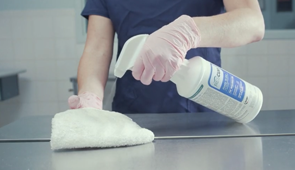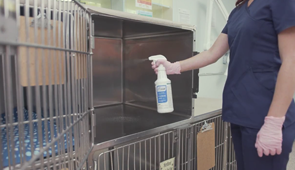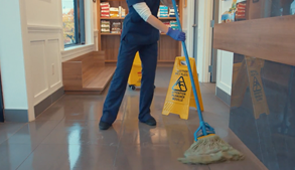Frequently Asked Questions
ACCELERATED HYDROGEN PEROXIDE®
What is AHP®?
AHP® is a patented synergistic blend of commonly used, safe ingredients that when combined with low levels of hydrogen peroxide dramatically increase its germicidal potency and cleaning performance. AHP® is composed of Hydrogen Peroxide, Surface Acting Agents (surfactants), wetting agents (a substance that reduces the surface tension of a liquid, causing the liquid to spread across or penetrate more easily the surface of a solid) and chelating agents (a substance that helps to reduce metal content and/or hardness of water).
RINSING
Do I need to rinse surfaces after using Rescue™?
You do not need to rinse surfaces that have been cleaned and disinfected with Rescue™. You may occasionally see a white streaky residue on some surfaces after using an AHP® product. Or, sometimes the floor may feel sticky after mopping.
This usually happens at higher concentrations of products. It is important to remember that in non-critical areas and for daily use, Rescue™ can be used at a dilution rate of 1:64 or 2 oz per gallon. At this concentration, streaks and stickiness are minimized.
If higher concentrations are required for disinfection, the streaks and stickiness can be removed by rinsing the surface with water and drying with a clean damp cloth. It is essential to allow for the required contact time before rinsing.
Watch Video: Streaking and Stickiness
SAFETY
Sometimes when I spray Rescue™ it makes me cough. Is it safe?
Rescue is non-toxic and non-irritating. The only active ingredient is hydrogen peroxide, a non-toxic substance that evaporates into oxygen and water. As with other liquids, if the user directly inhales sprayed, aerosolized solution, discomfort and coughing may result. Try not to spray and breathe in the aerosol in an enclosed area like a kennel. Spray and walk away.
You may also use a foaming applicator, which limits aerosolization of the solution.
Watch Video: Coughing
SAFETY
Do I need to wear gloves when using Rescue Wipes?
In accordance with the SDS (Safety Data Sheet) Rescue Disinfectant Wipes do not carry any hazard statements or hazard pictograms, and do not require the use of personal protective equipment (PPE) when handling the product. We do still recommend the use of gloves as a general practice when disinfecting, to help minimize the risk of disease transmission.
SOFT SURFACES
Does Rescue™ work on soft surfaces like carpets, upholstery, and laundry?
Soft surfaces or textiles include linens, towels, curtains, clothing, as well as upholstery and carpeting. Our product with a soft surface sanitizing claim is Rescue™ Ready to Use. Sanitizing lowers the number of bacteria on surfaces but does not eliminate them completely.
At this time the EPA (Environmental Protection Agency) does not allow for the approval of disinfection claims against viruses on soft surfaces such as carpets or bedding. AHP® could be used as a spot cleaner on areas that animals have defecated, urinated or vomited on. Assuming that the area is wetted thoroughly we would expect that there would be some inactivation against viruses.
AHP® products are registered disinfectants for the use on hard, non-porous surfaces. Therefore AHP products are not formulated for laundry use and should not be applied in your laundry machines.
EQUIPMENT
What equipment is needed to use Rescue™?
Using accessories can help make the disinfection process easier and more accurate. It is important to use equipment that is approved for use with Accelerated Hydrogen Peroxide® products. To learn more about specific approved accessories visit the individual product pages from the menu above.
While approved accessories can make diluting and storing Rescue™ easier, the minimum requirement is a simple measuring cup. If using unapproved equipment, solutions can become contaminated. Contaminated solutions should not be used.
Watch Video: Approved Accessories
TEMPORARY MUSTY ODOR
I just switched disinfectants. When I use Rescue™ there is a musty smell. Is it safe?
If you have recently switched to Rescue™ from a different disinfectant, you may notice a musty odor. That smell is Rescue™ removing residue that has built up on the surface over time. This is especially true if the last product that you used was a quaternary ammonium based disinfectant – known as a QUAT. After a few cleanings, Rescue™ will lift and remove the old residue and there will no longer be a smell.
A smell can also occur when using certain low-cost gloves. Hydrogen peroxide in Rescue™ reacts with sulphur powder that is left on some gloves after manufacturing. The smell is harmless – you can just keep using the gloves with the smell, rinse the gloves with water before using Rescue™ or switch to a different kind of glove.
Watch Video: Temporary Odor
LACK OF ODOR
Many cleaning and/or disinfecting products on the market have pleasant smells such as citrus and lime. Why doesn't AHP® have a scent?
The main reason for creating a scent-free product is to avoid masking odors. The smell of many cleaners and disinfectants are really just masking the odor of the chemical itself and ultimately the odor in the room or facility.
Clean has no fragrance. It is the absence of smell due to the absence of any odor causing materials. When you clean and disinfect with AHP® there isn’t a scent to mask the cleanliness. Your room or facility will eventually just smell clean.
CLEANING, SANITIZING, DISINFECTING, STERILIZING
What is the difference between cleaning, sanitizing, disinfection and sterilizing?
CLEANING is the physical removal of foreign material and organic material. Cleaning physically removes rather than kills microorganisms. It is accomplished with water, detergents, and mechanical action.
SANITIZING lowers the numbers of germs on surfaces or objects to a safe level, as judged by public health standards or requirements. This process works by either cleaning or disinfecting surfaces to lower the risk of spreading infection.
DISINFECTING is the inactivation of disease-producing microroganisms. Disinfection does not destroy bacterial spores.
STERILIZING is the level of reprocessing required when processing critical medical equipment/devices (equipment or devices that enter sterile tissue). Sterilization results in the destruction of all forms of microbial life including bacteria, viruses, spores and fungi.
MIXING PRODUCTS
Can I add other products like dish soap, scents or bleach to AHP products?
It is important that you do not add other products like bleach or fragrances when you are using Rescue™. The chemistry behind Rescue™, Accelerated Hydrogen Peroxide®, was formulated to be a potent germicide and effective cleaner. No other products are needed and mixing chemicals can be potentially dangerous.
Remember that AHP® products have excellent detergents – there is no reason to add additional cleaning products or fragrances to Rescue™. The smell of clean is no smell at all.
Watch Video: Mixing Products






